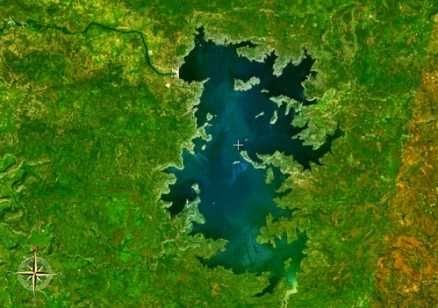Senegal River
The Senegal River watershed in West Africa has tributaries that rise in the nations of Guinea and Mali, with the Senegal course leading generally west to discharge into the Atlantic Ocean. The length of the Senegal River is generally regarded as approximately 1790 kilometres, making it the 75th longest river in the world and a major river of northwest Africa.
Hydroelectric power (Hydroelectric Power) exploitation has been carried out through dams at Diama and Lake Manitali; these facilities have also reduced flooding and allowed more managed agriculture in the prime growing area in the alluvial valley between Bakel and Dagana, where rice, millet, and vegetables are grown.
In the 1980s a program of dam-building in the Senegal Basin was undertaken for the well-intentioned purposes of flood control, prevention of saltwater influences, energy generation and agricultural expansion. While all the stated purposes of the United Nations were achieved, a much more pernicious unintended outcome has been realized in the form of an epidemic of parasitic worms that invade the human liver and urinary tract. The upstream reduction in salinity and floodwater prevention has created ideal conditions to promote an outbreak of the intermediate host snails that carry the disease organism through its larval stage. There is no treatment for this disease other than chemotherapy, the cost of which is beyond reach of almost all peoples inhabiting the basin. This is a common result in developing countries, where over 200 million people are currently infected with Schistomiasis worldwide.
Contents
River course
Upper watershed
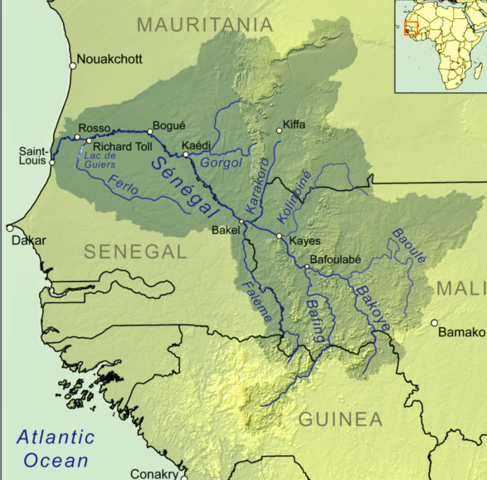 Senegal River Basin including tributaries. Source: K.Musser Of the headwater tributaries of the Senegal River, the Falémé and Bafing rise in the sandstones of the Fouta Djallon plateau within Guinea; Lake Manatali is a manmade body along the Bafing., whose damming greatly reduced the heavy seasonal flooding on the lower Senegal River. The Bakoye River, another tributary of the Senegal, originates in western Mali. The Bafing and Bakoye Rivers join at Bafoulabé within Mali to create the Sénégal River, around 1050 kilometres upstream of the Atlantic Ocean. The Falémé River confluence occurs near Bakel, Senegal.
Senegal River Basin including tributaries. Source: K.Musser Of the headwater tributaries of the Senegal River, the Falémé and Bafing rise in the sandstones of the Fouta Djallon plateau within Guinea; Lake Manatali is a manmade body along the Bafing., whose damming greatly reduced the heavy seasonal flooding on the lower Senegal River. The Bakoye River, another tributary of the Senegal, originates in western Mali. The Bafing and Bakoye Rivers join at Bafoulabé within Mali to create the Sénégal River, around 1050 kilometres upstream of the Atlantic Ocean. The Falémé River confluence occurs near Bakel, Senegal.
Lower watershed
From Bakel to Dagana, a distance of around 620 kilometres, the Senegal River runs through a very flat alluvial valley as much about 19 kilometres in width. Discharge to the Atlantic Ocean occurs at Saint-Louis, Senegal, an island city in the Senegal estuary. Floods arrive annually in early September at Bakel, reaching Dagana by middle October. During the flood season the water level rises 3.5 metres relative to dry season flow, attaining a flow rate roughly 300 times above the dry season values, and the Senegal River consumes virtually all of the broad level alluvial valley. Until construction of the Diama Dam 40 kilometres from the river mouth, tidal influence could be observed over 100 kilometres upstream from the mouth during dry season flow, owing to the extremely low gradient on this floodplain.
Climate
In the upper Senegal River catchment, Bafing and Falémé River sub-sheds receive approximately 2000 millimetres of rainfall per annum, chiefly falling from late March to early November; however, the Bakoye River Basin has less precipitation. The Senegal Valley itself enjoys substantially less direct rainfall, around 250 to 750 millimetres per year, and with a somewhat truncated rain season compared to the headwaters area, i.e. starting about a month later and ending a month earlier than the rainy season of the uplands. Temperatures in the Senegal Basin are hot, with lower reach mean maximum temperatures of around 42 degrees Celsius in April, and mean minimum temperatures in January about 18 degrees Celsius.
Fish species
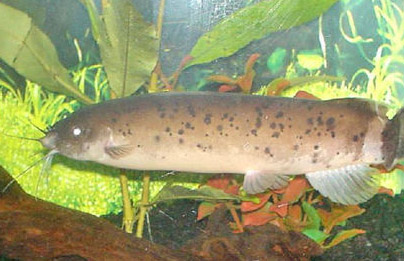 Electric Catfish. Source: Les Tapalia/Fishbase/EoL There are 141 species of fish recorded in the Senegal River, most of which are native; however, there are no endemic species of fish in the Senegal Basin. Among the larger native benthopelagic taxa are: the 170 centimetre (cm) North African Catfish (Clarias gariepinus), the 149 cm Electric Catfish (Malapterurus electricus), and the 92 cm African Carp (Labeo coubie).
Electric Catfish. Source: Les Tapalia/Fishbase/EoL There are 141 species of fish recorded in the Senegal River, most of which are native; however, there are no endemic species of fish in the Senegal Basin. Among the larger native benthopelagic taxa are: the 170 centimetre (cm) North African Catfish (Clarias gariepinus), the 149 cm Electric Catfish (Malapterurus electricus), and the 92 cm African Carp (Labeo coubie).
Some of the larger native demersal fishes of the Senegal Basin are: the 204 cm Aba (Gymnarchus niloticus). the 200 cm Nile Perch (Lates niloticus), the 183 cm Sampa (Heterobranchus longifilis), and the 150 cm Cornish Jack (Mormyrops anguilloides).
Pelagic native fishes in the Senegal River include the 65 cm True Big-scale Tetra (Brycinus macrolepidotus) and the 16 cm Ansorge Fangtooth Pellonuline (Odaxothrissa ansorgii).
Terrestrial vegetation
Lower reach flora
 Acacia tortilis in savanna setting. Source: Günther Eichhorn/EoL This reach of the river flows mostly through the Sahelian acacia savanna ecoregion, which is intercepted soon after the confluence with the Faleme, Karakoro and Kolimbine Rivers near the town of Bakel. The lower reach of the river has a maximum elevation of only about thirty metres and descends to sea level at Saint-Louis, Senegal. Dominant trees on the savanna are Umbrella Thorn (Acacia tortilis), Gum Senegal Tree (Acacia senegal), African Myrrh (Commiphora africana), Desert Date tree (Balanites aegyptiaca) and the Senegal Boscia tree (Boscia senegalensis). Growing close to the Senegal River is Gum Arabic Tree (Acacia nilotica).
Acacia tortilis in savanna setting. Source: Günther Eichhorn/EoL This reach of the river flows mostly through the Sahelian acacia savanna ecoregion, which is intercepted soon after the confluence with the Faleme, Karakoro and Kolimbine Rivers near the town of Bakel. The lower reach of the river has a maximum elevation of only about thirty metres and descends to sea level at Saint-Louis, Senegal. Dominant trees on the savanna are Umbrella Thorn (Acacia tortilis), Gum Senegal Tree (Acacia senegal), African Myrrh (Commiphora africana), Desert Date tree (Balanites aegyptiaca) and the Senegal Boscia tree (Boscia senegalensis). Growing close to the Senegal River is Gum Arabic Tree (Acacia nilotica).
Grass cover on the savanna of the lower reach includes Schoenefeldia gracilis and Aristida stipoides, which are well-represented here. Adrenaline Grass (Chrysopogon nigritanus) is found growing in moist localised depressions on the floodlplain. In the more northern Sahel areas of the watershed, grasslands grow on deep, sandy soils, with some woody species. Perennial desert species, such as Merkba Grass ( Panicum turgidum) alternate with typical Sahelian grassland.
Upper reach flora
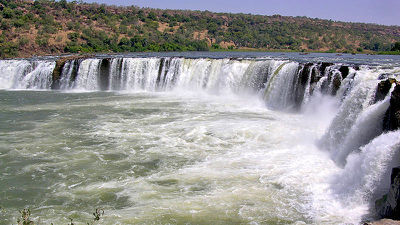 Gouina Falls in upper Senegal Basin, Mali. Source: Jacques Taberlet The vegetation comprises woody trees (which are mainly deciduous in the dry season, typically Combretum and Terminalia species with some Acacia), and an understory of long grasses, shrubs, and herbs. Hyparrhenia grass species are present in the upper watershed. Woodlands feature dry plant communities, normally under ten metres in height, represented by the Ngálǎma Tree (Anogneissus leiocarpus). and accompanied by Acacia spp., Desert Date (Balanites aegyptiaca), Kantakara Tree (Combretum glutinosum), African Myrrh (Commiphora africana), African Mesquite (Prosopis africana), Tamarind (Tamarindus indica), and Buffalo Thorn (Ziziphus mucronata). Elsewhere, wetter woodlands are found with Afzelia africana, Burkea africana, Combretum spp. and Terminalia spp. The Combretaceae and Leguminosae families are well represented in the upper reach.
Gouina Falls in upper Senegal Basin, Mali. Source: Jacques Taberlet The vegetation comprises woody trees (which are mainly deciduous in the dry season, typically Combretum and Terminalia species with some Acacia), and an understory of long grasses, shrubs, and herbs. Hyparrhenia grass species are present in the upper watershed. Woodlands feature dry plant communities, normally under ten metres in height, represented by the Ngálǎma Tree (Anogneissus leiocarpus). and accompanied by Acacia spp., Desert Date (Balanites aegyptiaca), Kantakara Tree (Combretum glutinosum), African Myrrh (Commiphora africana), African Mesquite (Prosopis africana), Tamarind (Tamarindus indica), and Buffalo Thorn (Ziziphus mucronata). Elsewhere, wetter woodlands are found with Afzelia africana, Burkea africana, Combretum spp. and Terminalia spp. The Combretaceae and Leguminosae families are well represented in the upper reach.
Terrestrial fauna
Lower reach fauna
Within the easternmost part of the lower reach a rare, limited range mammal is found, the Horned-skinned Bat (Eptesicus floweri). This bat is endemic to the Senegal River basin and the western part of the Sahelian acacia savanna ecoregion; the species also extends to the upper reach, and is found chiefly in acacia thickets and near desert grassland. Another restricted range endemic is the rodent Senegal Tateril (Taterillus pygargus); this mammal is usually found in thorny thicket, but also near desert scrub, and is thought to extend to the Senegal River upper reaches. The Sennar Penduline Tit (Anthoscopus punctifrons) is a bird endemic to the Sahelian acacia savanna, but its range extends eastward into the upper Senegal River basin (especially north of the Senegal River) and into the Sahel of northeastern Africa.
Upper reach fauna
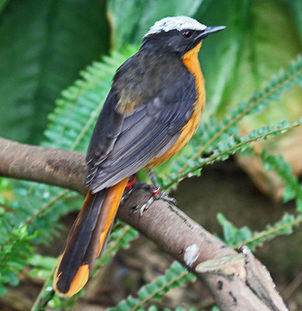 White-crowned Robin Chat. Source: Dick Daniels The Cinderella Shrew (Crocidura cinderella) is a restricted range shrew endemic to parts of the upper watershed, and may also occur on the Mauritanian side of the lower Senegal reaches. Bird species are considered near-endemic to the West Sudanian savanna and occurring in the upper reach watershed are: Long-tailed Cisticola (Cisticola dorsti) and White-crowned Robin-chat (Cossypha albicapilla); both species range widely to the eastern Sahel in addition to their occurrence in the Senegal River basin.
White-crowned Robin Chat. Source: Dick Daniels The Cinderella Shrew (Crocidura cinderella) is a restricted range shrew endemic to parts of the upper watershed, and may also occur on the Mauritanian side of the lower Senegal reaches. Bird species are considered near-endemic to the West Sudanian savanna and occurring in the upper reach watershed are: Long-tailed Cisticola (Cisticola dorsti) and White-crowned Robin-chat (Cossypha albicapilla); both species range widely to the eastern Sahel in addition to their occurrence in the Senegal River basin.
Larger mammals seen in the upper basin include Black Rhino, Leopard, Lion, Cheetah, Warthog, Striped Hyena and other charismatic wildlife.
There are several restricted range reptiles occurring in the upper reach, including Armitage's Cylindrical Skink (Chalcides armitagei), which is endemic to the West Sudanian savanna and also ranges somewhat to the south of the Senegal River basin into Gambia and Guinea Bissau. The Guinea Fringe-fingered Lizard (Acanthodactylus guineensis) is also endemic to the West Sudanian savanna and is found chiefly in the mouth area of the Niger River and the upper reaches of the Senegal Basin. Joger's Saw-scaled Viper (Echis jogeri) is an endemic snake to the West Sudanian savanna that occurs in the upper portion of the Senegal River Basin. Thierry's Cylindrical Skink (Chalcides thierryi) is also endemic to the West Sudanian savanna and is found in the upper Senegal Basin. The White-bellied Worm Snake (Myriopholis albiventer) is another endemic of the West Sudanian savanna found in the upper Senegal Basin. The racer Coluber dorri is also found in the upper reach of the Senegal River Basin, but may also occur in lower reaches; this taxon is another endemic to the West Sudanian savanna ecoregion.
Amphibians endemic to the upper reach include the Pale Running Frog (Kassina fusca), an anuran endemic to the West Sudanian savanna in the upper reach of the Senegal Basin and extening eastward at least as far as the Niger Basin; the Mali Screeching Frog (Arthroleptis milletihorsini), endemic to the West Sudanian savanna and found in the upper Senegal Basin; and Amietophrynus chudeaui, an anuran known only to Bata Marsh in Nioro Cercle, Mali.
Disease issues
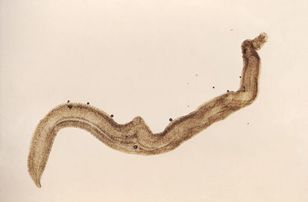 S. mansoni adult organism. Source: Natural History Museum London/EoL Malaria is a significant disease concern in the Senegal River Basin, partially due to the level of poverty and the lack of availability of simple intervention techniques for combatting the spread of this disease. In particular the level of malaria intervention techniques in the Senegal Basin is among the lowest in the world, and additional funding for this intervention was forthcoming in the year 2007, with significant funding being provided during the G.W. Bush Administration.
S. mansoni adult organism. Source: Natural History Museum London/EoL Malaria is a significant disease concern in the Senegal River Basin, partially due to the level of poverty and the lack of availability of simple intervention techniques for combatting the spread of this disease. In particular the level of malaria intervention techniques in the Senegal Basin is among the lowest in the world, and additional funding for this intervention was forthcoming in the year 2007, with significant funding being provided during the G.W. Bush Administration.
Outbreaks of Schistomiasis are of concern as unintended consequences of dam building and enhanced irrigation for agricultural expansion. Worldwide Schistomiasis is one of the greatest pathogenic diseases facing humans at the present time. For example the disease agent Schistosoma mansoni uses the local snail host biomphalaria pfeifferi for its intermediate development. Such snails have had a population explosion after some of the ill-conceived irrigation projects such as at Richard Toll, Senegal. After such snail population explosions, the disease agent S. mansoni has a mirror outbreak and leads to high levels of disease contamination in the river waters. When humans contact these waters the one centimetre long S. mansoni organism burrows into the human skin and infects the human liver and urinary tract.
Another trematode of importance in the basin is S. bovis whose aquatic snail host is typically B. truncatus. Downstream from the settlement of Richard Toll the possible infection of downriver waters and human populations from outbreaks of B. globosus is of concern. The overall disease pattern has been compounded by a rapidly expanding human population spurred by increasing agricultural productivity of the lower Senegal Basin and by massive influx of Mauritanian refugees fleeing instabilities created by Al-queda and other extremist militants. In many areas along the lower Senegal (e.g. Richard Toll) the human population more than quintupled over a three year period circa 1988-1991. This Human population explosion created strains on general sanitation infrastructure, since very little of the domestic wastewater is treated, and direct expulsion of human wastes to the river and its tributaries is commonplace. Thus diarrhea and intestinal human parasitic diseases have intensified in the lower basin since the early 1990s, but also intestinal schistosomiasis, a much more serious form of the disease has developed.
Ancient history
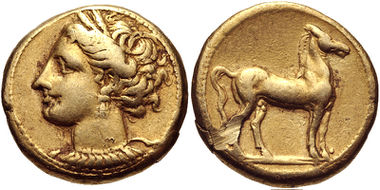 Carthaginian coinage c.late 4th century BC. Source: Jenkins & Lewis Group The earliest recorded history of the Senegal River was from Hanno the Carthaginian arriving from the Mediterranean Sea around 450 BC to explore the mouth of the river and establish trade with local tribes. Inland the Iron Age arrived to the region about 350 BC, when technology transfer overland occurred with peoples of the Nile Basin; the peoples who first practised such manufacture of iron tools were the ancient nation of Ghana (not exactly of the same boundaries as modern day country of Ghana). According to accounts of Pliny the Elder, an early name of the river was Bambotus, meaning hippopotamus in Phoenician.
Carthaginian coinage c.late 4th century BC. Source: Jenkins & Lewis Group The earliest recorded history of the Senegal River was from Hanno the Carthaginian arriving from the Mediterranean Sea around 450 BC to explore the mouth of the river and establish trade with local tribes. Inland the Iron Age arrived to the region about 350 BC, when technology transfer overland occurred with peoples of the Nile Basin; the peoples who first practised such manufacture of iron tools were the ancient nation of Ghana (not exactly of the same boundaries as modern day country of Ghana). According to accounts of Pliny the Elder, an early name of the river was Bambotus, meaning hippopotamus in Phoenician.
Modern history and international relations
In the nineteenth and early twentieth centuries French colonial influence was important thoughout the basin, with French becoming the first language of government and education. In 1959, Senegal and the French Soudan merged to create the Mali Federation, pursuant to independence and the transfer of power agreement signed with France on April 4, 1960. Due to internal political strife, the Mali Federation dissolved later in 1960. Senegal and Soudan (renamed the Republic of Mali) subsequently proclaimed independence.
By the year 2006 Senegal had developed strong economic ties with the USA following successive state visits to Senegal by President G.W. Bush, Secretary of State Colin Powell, First Lady Laura Bush and Secretary of State Condoleezza Rice. By 2007 USA aid to Senegal alone totalled $US 55.47 million. Technical economic aid from Canada, France, Italy and Germany were also present in the period 1995 to present. As of 2009 USA aid to the region effectively ended under the Obama administration. By 2010 China has become a dominant economic aid source to Senegal and other basin countries.
References
- C.Michael Hogan. 2007. Mogador: promontory fort, The Megalithic Portal, ed. A. Burnham
- Fishbase. 2010. Fish species in the Senegal Basin
- Mahamadou Maïga. 1995.Le bassin du fleuve Sénégal: de la Traite négrière au développement sous-régional autocentré, L'Harmattan (in French)
- Pliny the Elder. c. 74 AD. Naturalis historia. Rome
- Mamdouh Shahin. 2002. Hydrology and Water Resources of Africa, Kluwer. New York, NY ISBN9781402008665.
- R.F. Sturrock, O.T. Diaw, I. Talla, M. Niang, J.-P. Piau and M. Capron. 2002. Seasonality in the transmission of Schistosomiasis and its populations of snail intermediate hosts in and around a sugar irrigation scheme at Richard Toll, Senegal. in Flukes and Snails Revisitedm edited by D. Rollinson, L.H. Chappell. Cambridge University Press
- United Nations. 1903-1974. Hydrographic data for Dagana, Senegal, Unesco International Hydrological Programme
- United Nations. 2012. Senegal River Basin (Guinea, Mali, Mauritania, Senegal). World Water Assessment Programme.
